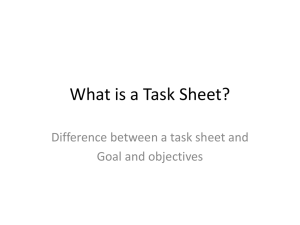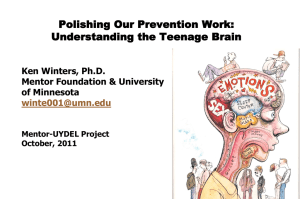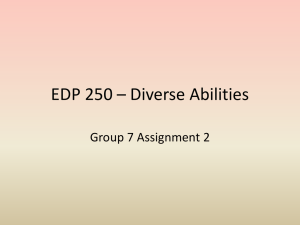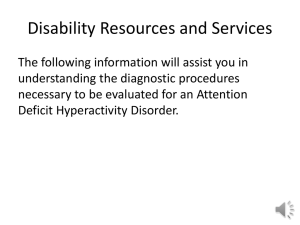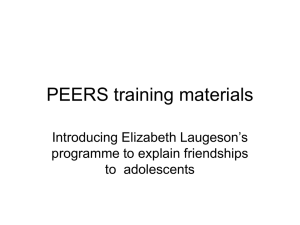ADHD as OHI Eligibility Final - Big East Educational Cooperative
advertisement
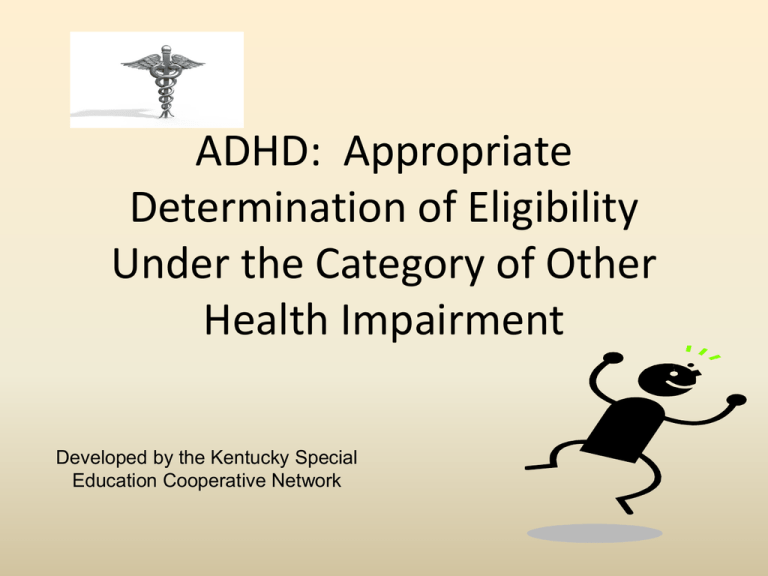
ADHD: Appropriate Determination of Eligibility Under the Category of Other Health Impairment Developed by the Kentucky Special Education Cooperative Network Definition: Other Health Impairment Other health impairment (OHI) means having limited strength, vitality, or alertness, including a heightened alertness to environmental stimuli, that results in limited alertness with respect to the educational environment, that: a) is due to a chronic or acute health problem e.g., as acquired immune deficiency syndrome, asthma, attention deficit disorder or attention deficit hyperactivity disorder, diabetes, epilepsy, a heart condition, hemophilia, lead poisoning, leukemia, nephritis, rheumatic fever, sickle cell anemia, Tourette syndrome, or tuberculosis; and b) adversely affects a child’s educational performance. 34 CFR 300.8 (c) (9) 707 KAR 1:280 Section 1 (42) KRS 157.200 (1) (b) Definition: A Chronic or Acute Health Problem includes a non-exhaustive list that covers health problems such as acquired immune deficiency disease, asthma, attention deficit disorder, attention deficit hyperactivity disorder, diabetes, epilepsy, heart condition, hemophilia, lead poisoning, leukemia, nephritis, rheumatic fever, sickle cell anemia, Tourette syndrome and tuberculosis. 34 C.F.R. 300.8 (a) (9) 707 KAR 1:280 Section 1 (42) OHI means having limited: STRENGTH VITALITY ALERTNESS Definition: Limited Strength includes the endurance of fine and gross motor skills and activities including trunk control, slouching, and the maintenance of posture. It may also include how the student’s emotional stamina and how the student deals with stress or pain. Definition: Limited Vitality includes physical and mental endurance (duration, intensity, and frequency over time) in an activity as measured by work completion; time on task; and the number of times the student took a break. Definition: Limited Alertness including a heightened alertness to environmental stimuli, in the focus on tasks, activities, and responses, as measured by whether the student has a short attention span (i.e., pays attention to nothing) or is highly distractible (i.e., pays attention to everything). Types of ADHD • Primarily Inattentive • Primarily Hyperactive-Impulsive • Combined Type Look For: Primarily Inattentive: • Makes careless mistakes • Has trouble sustaining attention • Seems not to listen • Has difficulty following directions • Disorganized • Losses things • Forgetful Primarily Hyperactive-Impulsive: • Fidgets or squirms frequently • Often runs, climbs and is restless • Has difficulty working or playing quietly • Always seems on the go • Talks excessively • Blurts out answers before question is finished • Difficulty waiting turn • Interrupts others Eligibility Determination Who Can Make The Diagnosis? Specialty Can Diagnose ADHD? Can Prescribe Medication if needed? Provides counseling or training? Psychiatrists Yes Yes Yes Psychologists Yes No Yes Pediatrician or family physician Yes Yes Usually, no Neurologists Yes Yes No This chart from the National Institute of Mental Health lists the types of doctors who are qualified to diagnose and supervise treatment for ADHD, although not all may have specific training in this disorder. The affect of the health problem resulting in limited strength, vitality, or alertness: How does the health problem limit the student’s strength? • What is the expectation for similar age peers for strength? • How does the student differ in this area from peers? How does the health problem limit the student’s vitality? • What is the expectation for similar age peers for vitality? • How does the student differ in this area from peers? How does the health problem limit the student’s alertness? • What is the expectation for similar age peers for alertness? • How does the student differ in this area from peers? Possible Data Sources: Behavior Observations, Data Logs • Determine how and when the child is inattentive, impulsive and/or hyperactive • Carefully examine the environment to determine WHY (rule the following out): – Is the task too hard, too easy? – Were the expectations made explicit? – Is there a pattern of events that allows for prediction of the inattentive, impulsive and/or hyperactive behavior Possible Data Sources: Rating Scales • Will tell you whether the child’s behavior is significantly different from peers • Will NOT tell you WHY • Ratings should be gathered across settings – If the problem doesn’t occur in most/all settings, it is an environmental problem rather than a “within the child” problem • Possibilities: Conner’s Rating Scales- Revised, Brown Attention Deficit Disorder Scales Possible Data Sources: Curriculum Based Assessment • Assessment based on the grade level curriculum • Given to ALL students • Assessed three (3) times per year • Possibilities: PAS, Diebels, GMADE, GRADE Possible Data Sources: Direct Assessment • Conner’s Continuous Performance Test – Computer based assessment – Measures ability to attend to a boring task – Measure impulsivity Definition: Adverse Affect the progress of the child is impeded by the disability to the extent that the educational performance is significantly and consistently below the level of similar age peers. 34 CFR 300.8 707 KAR 1:280 Section 1 (2) Eligibility Determination: Adverse Affect • Review all student assessment results • Compare student performance to peers • The ARC determines “Adverse Affect” when: Eligibility Determination: Adverse Affect 1. The disability related to the health problem impedes progress to the extent that educational performance is significantly and consistently below the level of similar age peers. Eligibility Determination: Adverse Affect 2. The disability related to the health problem interferes with acquiring, developing, understanding, or applying knowledge or skills needed to be included in and progress in the general curriculum Eligibility Determination: Adverse Affect 3. The disability related to the health problem affects the student to such a degree that special education and related services are needed in order to benefit from education. Exclusionary Clause The student is not eligible for services if the ARC determines: • A lack of instruction in reading • A lack of instruction in math • The student is limited English proficient • The student child does not meet eligibility criteria IEP Development The ARC determines specific areas of need for the student that result from the ADHD. The ARC considers the areas specifically related to the student’s: –Limited strength –Limited vitality –Limited alertness Example: Larry Larry: 10 years; medical diagnosis of ADHD Limitations from ADHD: – Distractible – Peers are expected to stay on task for 20 minutes without distractions or interruptions. When given a 20 minute period of time and a 10 question handout to complete, he writes his name and the date, and works on the first question; he is on task a total of 5 minutes. – Accommodations the teacher has used include setting a timer to complete his work, working in a study carrel, and assigning completion of 2/3 of his assignments Additional data on Larry • Curriculum based measures indicate that Larry is performing well below the average of the class in reading and math. Due to his lack of attention, he is failing to acquire and understand the curriculum content. The ADHD (his health problem) causes his distractibility and off task behavior; he needs to learn specific strategies and generalize to other settings, so that he may begin learning the content he has missed (i.e., specially designed instruction) • A review of his grades, the curriculum, and his performance indicate that he has been provided appropriate instructional opportunities in reading and math, and the ARC ruled out a learning disability or another disability. Other Data Needed • What reading, writing, and math skills has this student gained? (Remove the impact of the distractibility when assessing) • What are the specific skills that this student has missed? (Remove the impact of the distractibility when assessing) Needs Related to the Disability • Decrease Distractibility • Increase on-task behavior • Increase work completion What are NOT areas of need for this student? • This student’s needs are NOT in reading and math. The ADHD causes the distractibility, causing the off task behavior and lack of work completion. If a student is not on task, the student can not and will not learn the skill being taught. • The IEP should address the needs of the student that result from the disability, which is distractibility. • Once the student is taught (through specially designed instruction) specific strategies that will help him develop, understand, and apply the strategies to decrease his distractibility, his on task behavior and his work completion will improve ? ? ? If the student doesn’t need goals in reading or math, what kind of goals are needed? ? ? ? Possible IEP Goals from Academic Expectation 2: • AE 2: develop abilities to apply core concepts…..to what they will encounter throughout life • AE 2.32: Demonstrate strategies for becoming and remaining mentally and emotionally healthy • AE 2.37: demonstrate skills and work habits that lead to success in future schooling and work Possible IEP Goals from Academic Expectation 3: • AE 3: Develop their abilities to become selfsufficient individuals • AE 3.5: Demonstrate self-control and selfdiscipline • AE. 3.7: Demonstrate the ability to learn on one’s own Possible IEP Goals from Academic Expectation 5: • AE 5: Develop their abilities to think and solve problems in school situations and in a variety of situations they will encounter in life • AE 5.1: Use critical thinking skills such as analyzing, prioritizing, categorizing, evaluating, and comparing to solve problems in a variety of real-life situations • AE 5.3: Students organize information to develop or change their understanding of a concept Possible IEP Goals from Academic Expectation 6: • AE 6: Develop their abilities to connect and integrate experiences and new knowledge from all subject matter fields which what they have previously learning……. • AE 6.2: Use what they already know to acquire new knowledge, develop new skills, or interpret new experiences • AE 6.3: Expand their understanding of existing knowledge by making connections with new knowledge, skills and experiences Example Benchmarks: On-task behavior GOAL: Demonstrate self-control and self-discipline BENCHMARKS: • Complete 80% of work at 80% accuracy rate • Begin working on assignment within 2 minutes of directions begin given • Follows directions with less than 2 personal prompts • Works on class assignments for 10 minutes before taking break (baseline data provides the target number of minutes) Specially Designed Instruction • Direct teaching of what “on-task” behavior looks like through role-playing • Direct teaching of self-monitoring strategies with reinforcement for close approximations of the benchmark • Direct teaching of listening strategies Supplementary Aids and Services • Use of a visual cue to get back on task • Break tasks into parts and frequently check on- task progression • Reinforce for correct on-task behavior when it is displayed –even if it is displayed for only a short period of time • Allow for movement breaks that involve heavy lifting or fast movements such as taking a note to the office What Accommodations, if any, would be needed for instruction and assessment? • Review what the student gets regularly for SDI • Review what the student gets regularly for SAS Example Benchmarks: Overall Organization GOAL: Organize information to develop or change understanding of a concept BENCHMARKS: • Maintain a notebook according to system taught with at least 85% of papers in the correct section of the notebook during weekly teacher student conferences • Come to class with required materials 4/5 days for each class • Complete and turn in 85% of homework in each class • Come to class on time at a rate of 95% Specially Designed Instruction • Directly teach a notebook organization system with re-teaching and monitoring of the system each week during case manager-student conference • Reinforce the student for increasing the level of compliance with the notebook system – Note: to do this appropriately, you must assess what is reinforcing to the student in a systematic way Supplementary Aids and Services • Provide a consistent area in the classroom for work to be left • Check with the child frequently and look at the notebook to help him/her learn the system • If assignments are not turned in, the general education teacher will notify the case-manager and discuss whether extra time is needed to find or re-do the assignment. While the student is learning this skill, points will not be removed for late work. This is a temporary accommodation while the skill is being learned. The decision on when or whether to count off for late work should be a joint decision between the content teacher and the case manager. What Accommodations, if any, would be needed for instruction and assessment? • Review what the student gets regularly for SDI • Review what the student gets regularly for SAS Sample Benchmarks: Organization for academic tasks • Written paragraphs have a topic sentence • Written paragraphs have 3 or more supporting details • All items on work sheets are completed with none left out Specially Designed Instruction • Directly teach the student to use a graphic organizer to complete writing assignments • Directly teach the student to divide worksheets into sections and scan work for missed items before turning it in • Directly teach a system of self assessment: – – – – Did I complete all items? Did I answer all parts of the question? Read the work to make sure words are not omitted Did I do my best work? Supplementary Aids and Supports • Frequently check with the student to ensure understanding of the graphic organizer • Require the student to complete work left blank. While the student is learning this skill, points will not be removed for work completed after originally turned in. This is a temporary accommodation while the skill is being learned. The decision on when or whether to count off for late work should be a joint decision between the content teacher and the case manager. What Accommodations, if any, would be needed for instruction and assessment? • Review what the student gets regularly for SDI • Review what the student gets regularly for SAS When the Health Impairment Impacts Reading Skills: Sample Present Level According to curriculum based assessments, Johnny’s basic reading is commensurate with peers. When reading for comprehension, Johnny reads too fast and cannot identify the main idea and supporting details that help him understand the concepts and content. Johnny’s lack of attention to what he reads impacts his ability to read and understand for meaning. Sample Benchmarks: When Attention Deficits Significantly Impact Reading Skills • Johnny will identify the main idea of a grade level reading passage • Johnny will give 3 supporting details from a grade level reading passage Specially Designed Instruction • Direct instruction in pre-reading strategies to set the stage for identification of the main concept • Direct instruction in text cues which point to the main idea • Direct instruction in the use of a graphic organizer to take short notes when reading. Specifically, the graphic organizer will provide a spot to note important supporting details Supplementary Aids and Services • When reading is expected in the classroom, the teacher will give Johnny a cue designed to help identify the main idea • As a part of reading assignment instructions, the teacher will review the organization of the reading passage. The purpose of this is to cue the student as to ways of identifying the main idea as well as the supporting details that are most critical • Teachers will provide a graphic organizer for Johnny when reading for detail is part of the classroom activity. Johnny will earn bonus points for use of this graphic organizer in order to reinforce his use of the strategy What Accommodations, if any, would be needed for instruction and assessment? • Review what the student gets regularly for SDI • Review what the student gets regularly for SAS When The Health Impairment Impacts Math Skills: Sample Present Level Johnny does not understand the concept of regrouping within any mathematical concept (addition, subtraction, multiplication, division). His inability to maintain focus has prevented his understanding of this concept. Within the general education environment, Johnny has received both Level II (30 ½ hour sessions within 45 school days) and Level III interventions (2 30 min sessions on 40 of 60 school days) which have not been successful in helping him master this skill. Sample Benchmarks: When Attending Deficits Significantly Impacts Math Skills • Johnny will utilize strategies to determine whether regrouping is needed within a given math problem with 95% accuracy • Johnny will correctly utilize regrouping in 80 % of math problems presented Specially Designed Instruction • Direct teaching of strategies to assess math problems to determine whether regrouping is needed • Direct instruction (with a visual cueing system) in the steps for regrouping in a variety of problems • Instruction in a self-monitoring strategy to check work and determine whether regrouping was appropriate Supplementary Aids and Services • Visual cueing system will be present on Johnny’s desk to help determine whether regrouping is needed • When errors are made, Johnny will correct the work with the assistance of his case-manger who will utilize cognitive strategies to help him understand the error and why he made it. • Additional time may be needed to get this process complete. The case-manager and teacher will negotiate how much time is needed to complete this process. • The grade earned after the correction phase will be his recorded grade. This is a temporary accommodation and will be faded as Johnny learns the skill. It should be noted, however, that Johnny has had considerable intervention in this area so the skill may take time to learn. What Accommodations, if any, would be needed for instruction and assessment? • Review what the student gets regularly for SDI • Review what the student gets regularly for SAS Tying it all together: Addressing Needs that Relate to the Disability Present Levels Identified Need Annual Goal Benchmarks/ Methods of Measurement Curriculum based measures indicate that Larry is performing well below the average of the class in reading and math. Due to his lack of attention, he is failing to acquire and understand the curriculum content. The ADHD (his health problem) causes his distractibility and off task behavior; he needs to learn specific strategies and generalize to other settings, so that he may begin learning the content he has missed (i.e., specially designed instruction). Increase on-task behavior Develop his ability to become a self-sufficient individual As measured by performance based on criteria established within rubrics to assess on task behaviors: Complete 80% of work at 80% accuracy rate Begin working on assignment within 2 minutes of directions begin given Follows directions with less than 2 personal prompts Works on class assignments for 10 minutes before taking a break The ARC should articulate the following: How does the health problem limit the student’s strength? • What is the expectation for similar age peers for strength? • How does the student differ in this area from peers? How does the health problem limit the student’s vitality? • What is the expectation for similar age peers for vitality? • How does the student differ in this area from peers? How does the health problem limit the student’s alertness? • What is the expectation for similar age peers for alertness? • How does the student differ in this area from peers? If the ARC cannot articulate the information from the previous slide, there is not a clear understanding of the child’s issues. The ARC should always consider the possibility that the child may have a disability which DOES NOT require specially designed instruction. This child would not be considered a child with a disability under IDEA. While ADHD can certainly be a DISability with a negative impact ADHD does have a positive side
